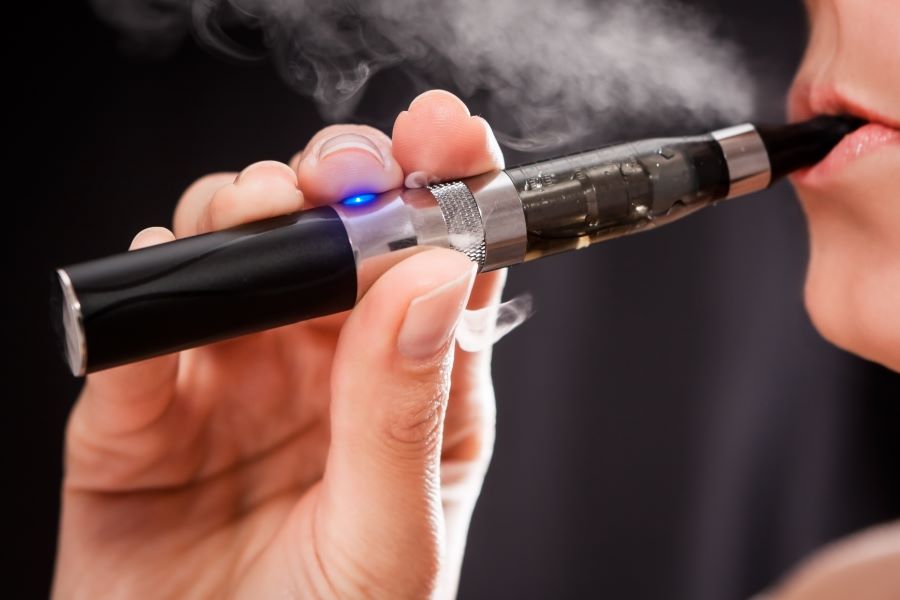Why it’s not oK to Smoke E-cigarettes Around Kids

Electronic cigarettes (also known as e-cigarettes, e-cigs, vapors or nicotine vaporizers) are battery-powered devices designed to mimic the smoking experience without burning tobacco. They’ve exploded in popularity as a “safer” alternative to smoking, and e-cigarettes can now regularly be seen on TV and in the media.
E-cigarettes do not use tobacco, but instead heat a liquid containing nicotine, flavorings, and other chemicals until it becomes a vapor, which can then be inhaled. It’s sometimes called “vaping.”
Users don’t inhale the same levels of tar and carbon monoxide that they would when smoking traditional cigarettes, but e-cigarettes are far from being a healthy alternative to smoking.
Nicotine is a highly addictive drug and toxic in high doses. It affects the brain, nervous system, and heart—raising blood pressure and causing an abnormal heart rate. Over time, nicotine use can lead to heart disease, blood clots, and stomach ulcers. Withdrawal from nicotine may make people feel depressed, tired, and irritable. All of these dangers apply to users of e-cigarettes.
Nicotine is not the only dangerous chemical found in e-cigarette liquid. According to a 2009 announcement, the U.S. Food and Drug Administration (FDA) found diethylene glycol, a chemical used in antifreeze and “detectable levels of known carcinogens and toxic chemicals to which users could potentially be exposed.”
These are relatively new products often sold with misleading claims, such as:
CLAIM: E-cigarettes help smokers quit.
TRUTH: There is no scientific evidence that using e-cigarettes can help you quit smoking and they are not approved by the FDA as a smoking cessation tool. Because e-cigarettes are marketed with flavors like chocolate and strawberry, they may actually encourage nonsmokers (especially kids) to try vaping.
CLAIM: E-cigarettes can be used anywhere, even in “non-smoking” areas.
TRUTH: Laws vary from state or state (or even within some states). In general, e-cigarette use is NOT permitted in the same places where smoking is prohibited.
CLAIM: There is no “secondhand” risk with e-cigarettes.
TRUTH: For smokers, the term “secondhand” refers to smoke coming from tobacco being smoked by another person or exiting the lungs of someone smoking. For e-cigarettes, “secondhand” would similarly refer to someone inhaling vapors because they are near people using the device. There has not been enough research conducted on e-cigarette use to determine whether secondhand vapors are harmful or to what extent. Yet, a 2012 study did find that exhaled vapors contained measurable amounts of carcinogens.
CLAIM: You can get “nicotine-free” e-cigarettes.
TRUTH: The FDA’s initial analysis of e-cigarettes in 2009 found low levels of nicotine in products labeled as “nicotine free.”
The FDA regulates tobacco products including cigarettes, cigars, pipe tobacco and smokeless tobacco as well as approved products for quitting smoking (gums, patches, medications). However, it does NOT currently regulate e-cigarettes. Manufacturers are not required to disclose the chemicals in its liquids or in what amount these are inhaled and exhaled by the user. In April 2014, the agency proposed a series of regulations for the e-cigarette market, but nothing had been passed as of early 2015.
Sources:
- FDA
- E-Cigarettes: Questions and Answers.
FDA - E-Cigarettes.
American Legacy Foundation - E-Cigarette Fact Sheet.
American Nonsmokers’ Rights Foundation.U.S - State and Local Laws Regulating Use of Electronic Cigarettes.
Americans for Nonsmokers’ Rights - E-Cigarettes.
Powered by Bundoo®










